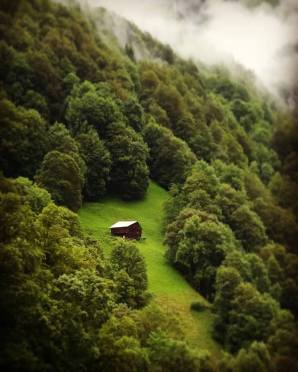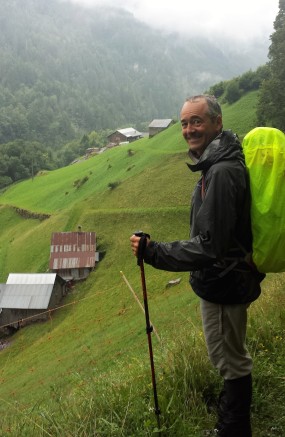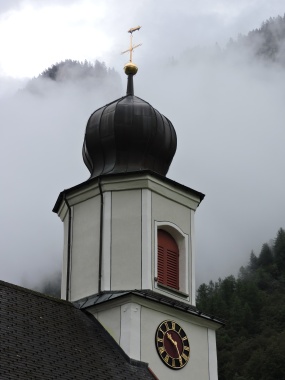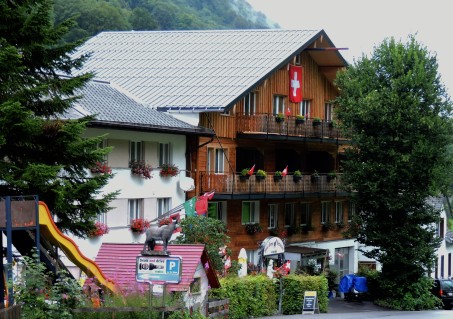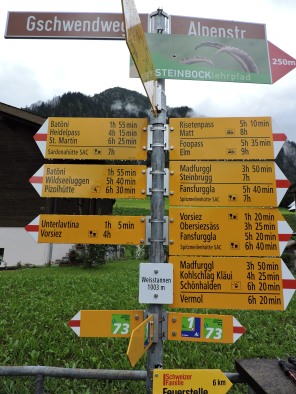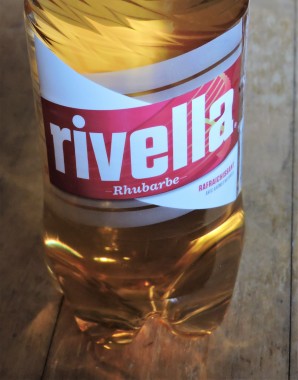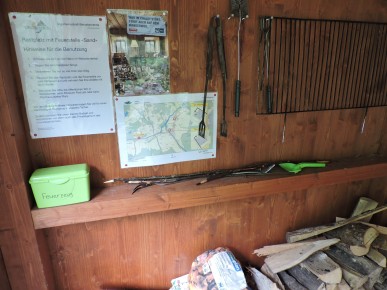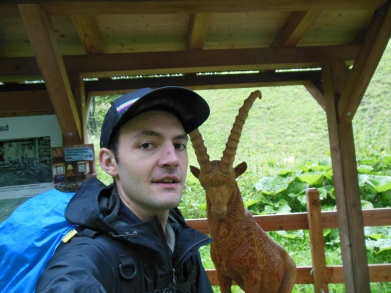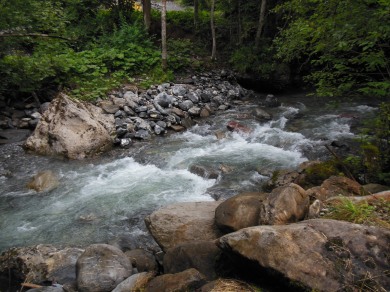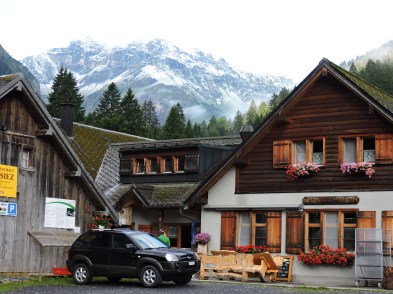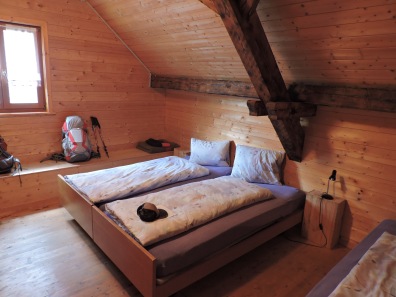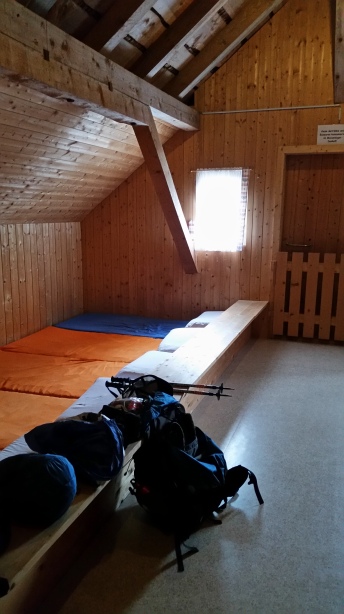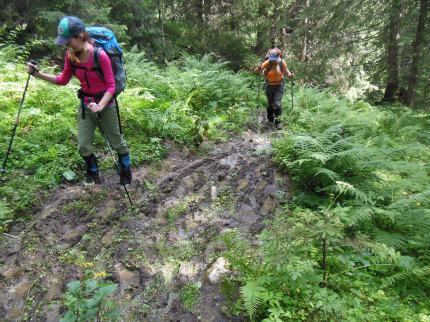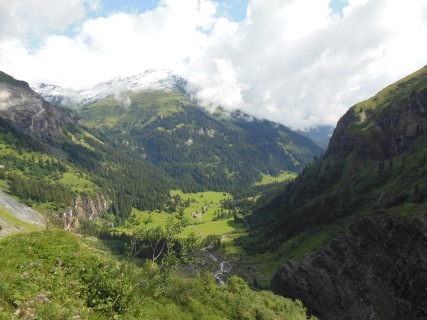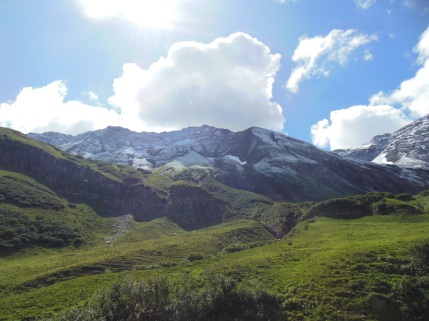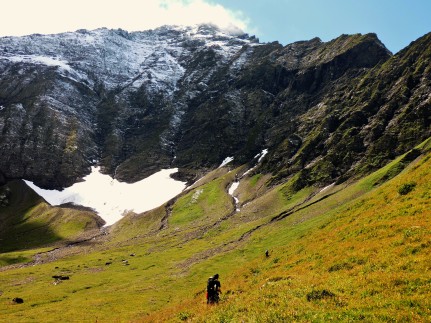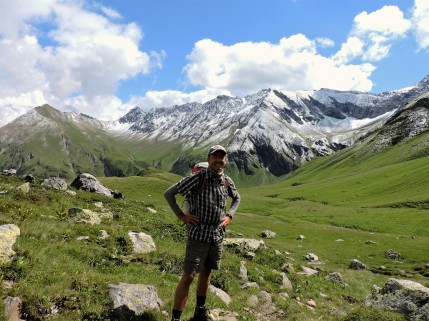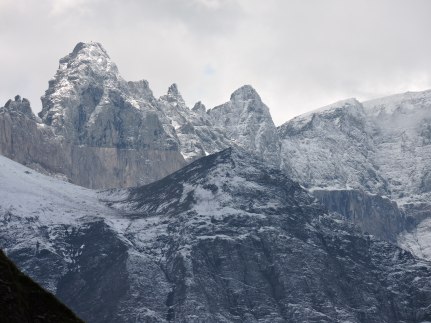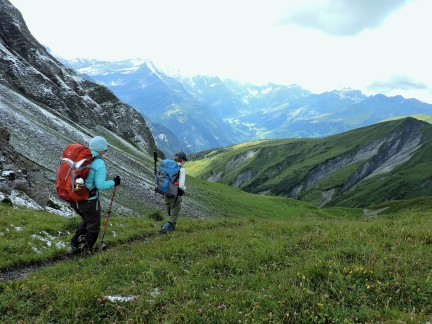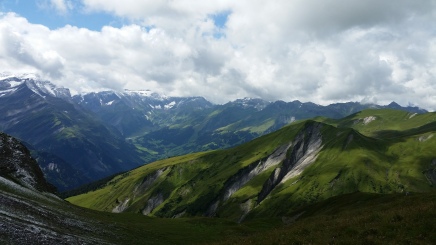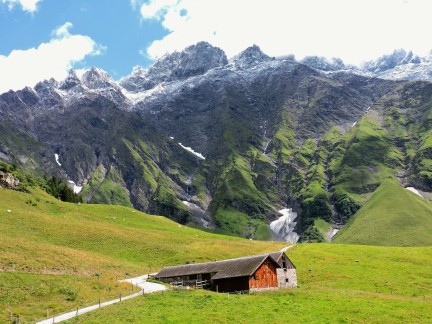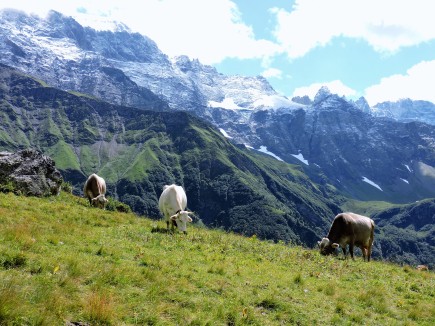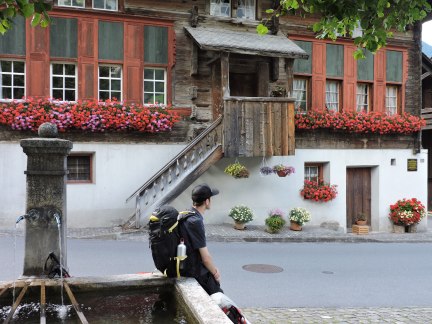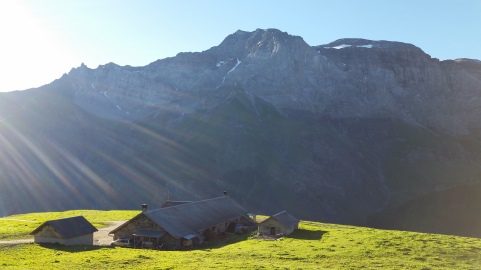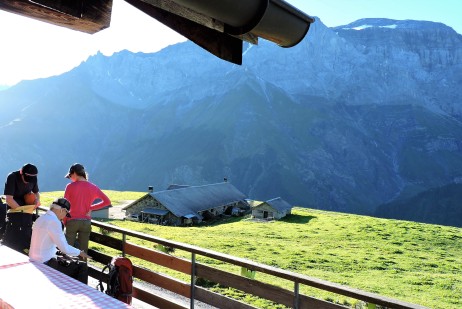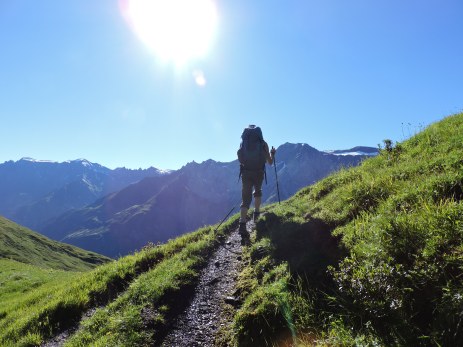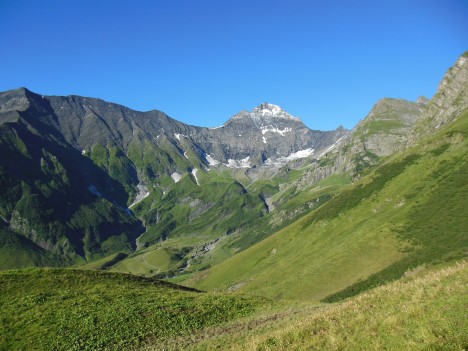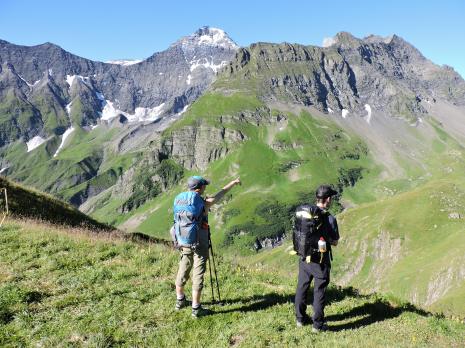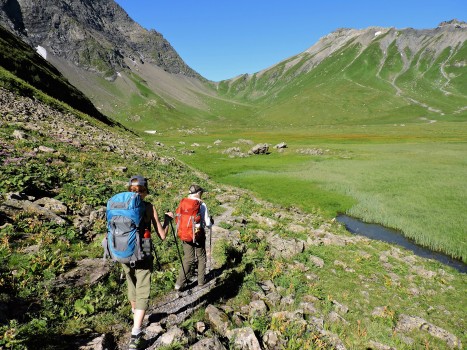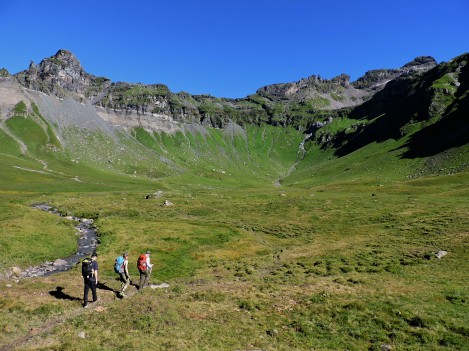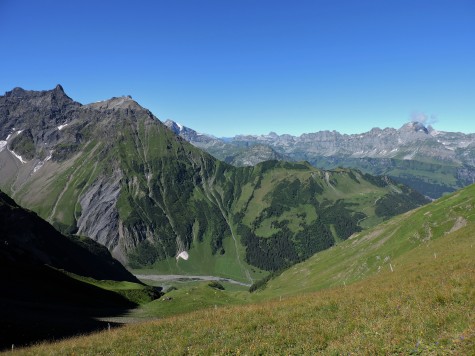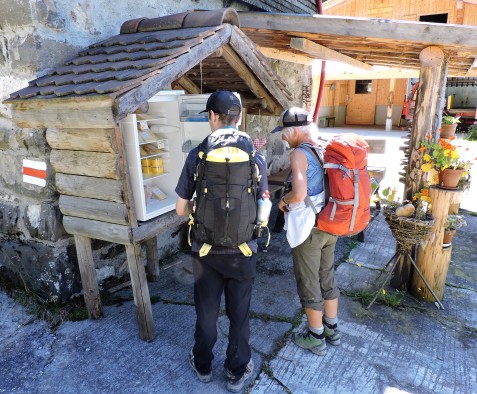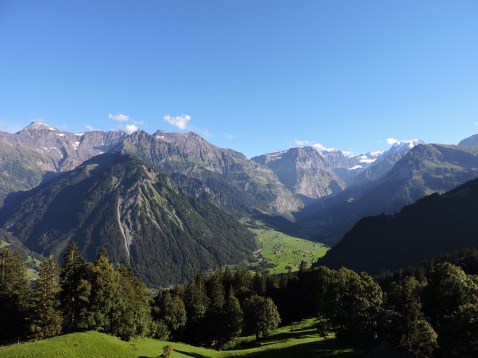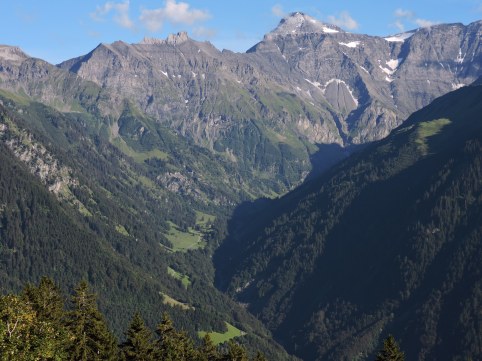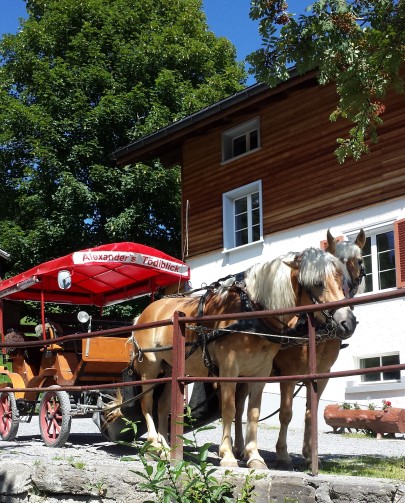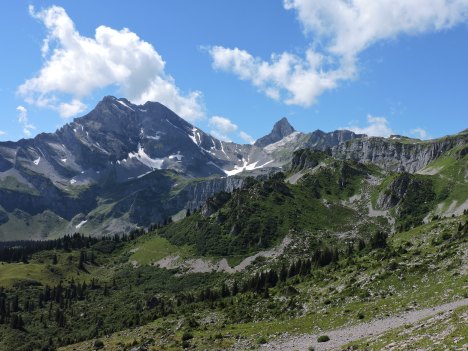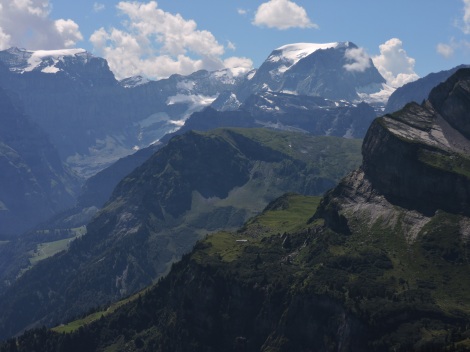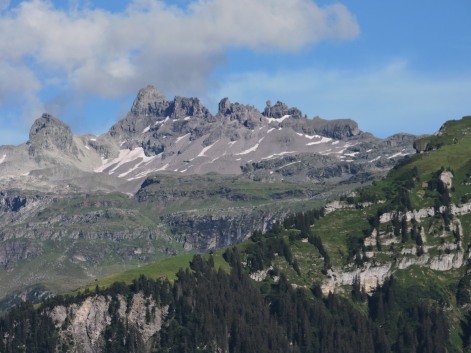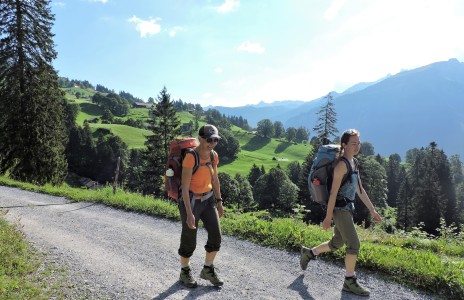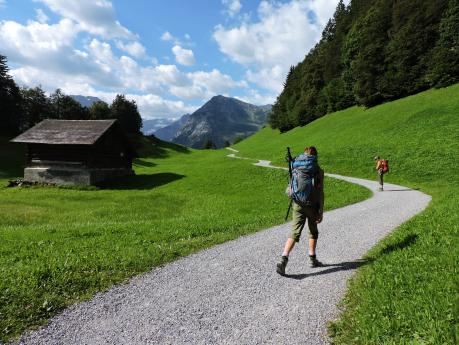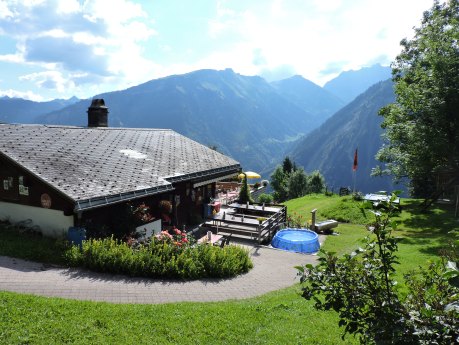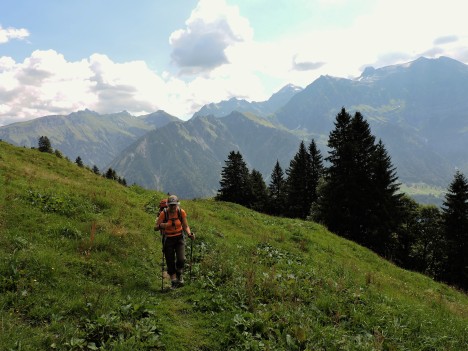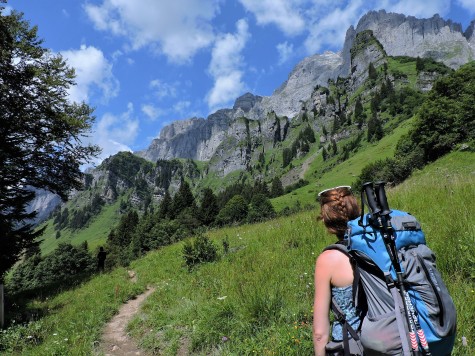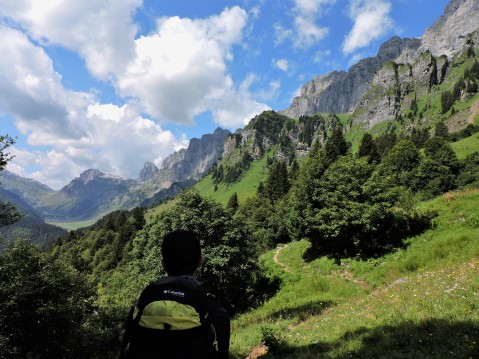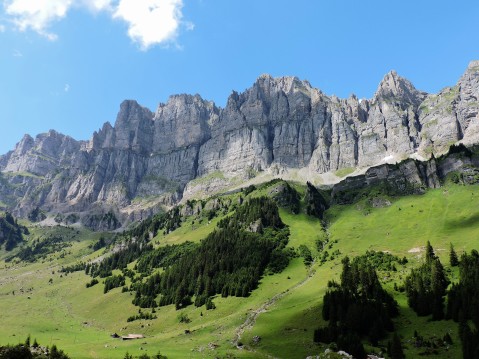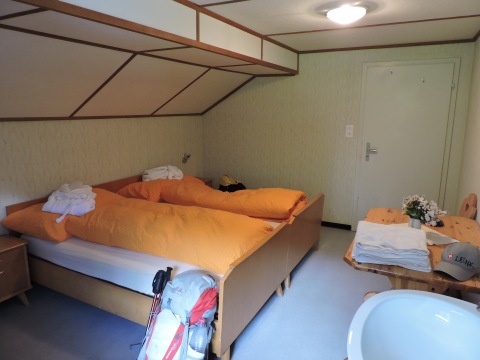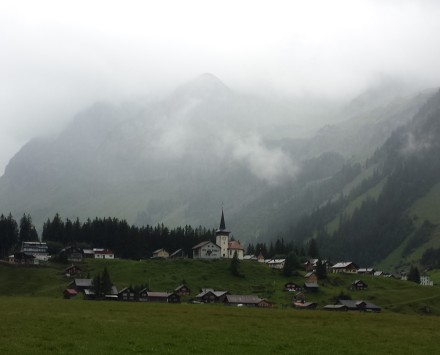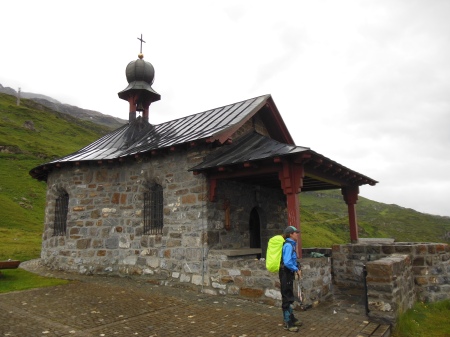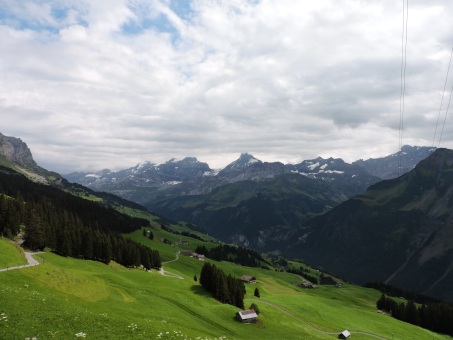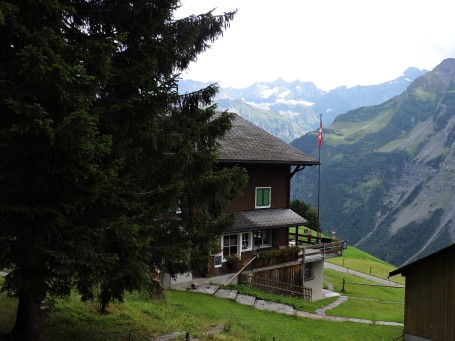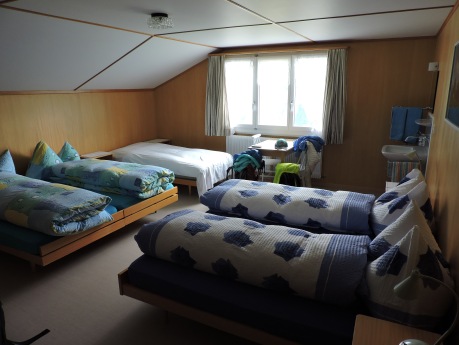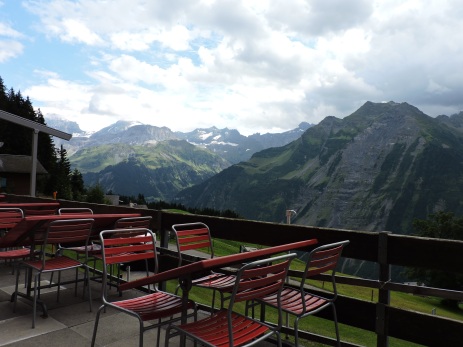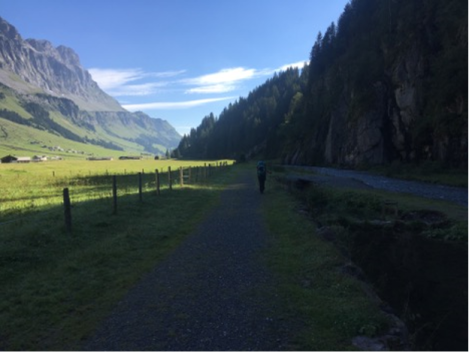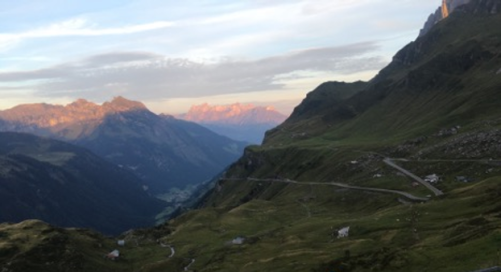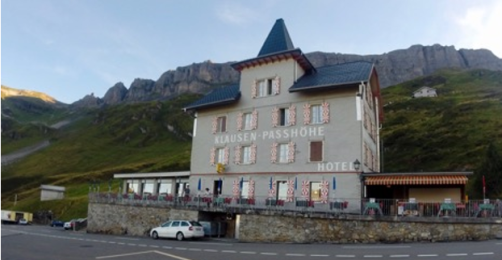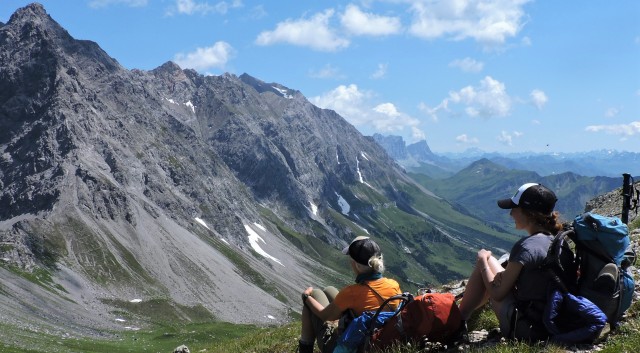
At Gross Furgga on the Austrian border, looking ahead into Switzerland (toward Schesaplanahütte).
This blog is devoted mostly to the Via Alpina “green trail” which extends East-West across the Alps in Switzerland. (At the bottom of this post, I’ll repeat how to find my 2013 and 2016 posts about hiking the “green trail”). But in this post, I’ll mention my July-August 2019 hike (with my wife and daughter) on just a few stages of the Via Alpina “red trail” through Liechtenstein, a small part of Austria and the Prättigau region of the Swiss canton of Graubünden. The red trail is by far the longest of the five Via Alpina routes, beginning in Slovenia and ending in Monaco. In 2019, we decided to hike just a few stages of that extremely long trail.
We began at the end of July in Liechtenstein at Berggasthaus Sücka, which is located literally right on the red trail. We got there via train and bus from Zürich airport (train from the airport to Sargans, Switzerland, then Liechtenstein bus to the Steg tunnel bus stop in Liechtenstein. It’s just a third of a mile hike uphill from the bus stop to the Berggasthaus). The Berggasthaus was clean, neat and comfortable. Adjacent to the lodgings is a working dairy farm, where cows are brought in very early each morning and in the evening for milking (complete with jangling cowbells). However, the older woman proprietress was very brusque (sometimes to the point of rudeness), and never particularly accommodating. Dinners were very good. Breakfast was adequate. When we asked the proprietress to make us lunch packets for the next day (typical in alpine huts and hotels) she refused, and instead told us to make our own sandwiches from the bread, cheese and meat on the breakfast buffet table (and then charged us quite a bit for that).
We spent two nights at Sücka. On our first full day there, we backtracked on the Via Alpina red trail (without our packs, which we left in the Berggasthaus) to day hike the previous stage of the Via. That took us through the Fürstensteig (Prince’s Climb), a famous trail segment carved out of the rocky cliffs in 1898. Unfortunately, the weather was dark (either rainy or foggy) all day, so our photos don’t fully reflect how spectacular the trail really was. Suffice it to say that this was the most exciting trail I’ve ever hiked in more than 50 years of hiking. Narrow tread, breath-taking exposure (one side drops off precipitously all the way down to the Rhine Valley), steep scrambles, plank bridges over deep gaps. Tons of adrenaline-fueled fun! Plus, we were all alone on the trail, which made the experience even more enjoyable.
The following day, we hoisted our packs and proceeded ahead on the Via Alpina red trail to Pfälzerhütte, owned by the Liechtenstein Alpine Club. What a location! It straddles the knife-edge border between Liechtenstein and Austria, with stunning mountain views in all directions. There are several very enjoyable opportunities from Pfälzerhütte for day hikes and peak bagging.
The hut offers both rooms (with bunk beds) as well as a massenlager dormitory (with 51 spaces). Compared with other alpine huts we have stayed in, the food was fairly good (but not great). The exception was the freshly-baked goodies available for mid-afternoon snack (cherry, cheese and apricot or carrot cake, as well as apple strudel), which were out-of-this-world.
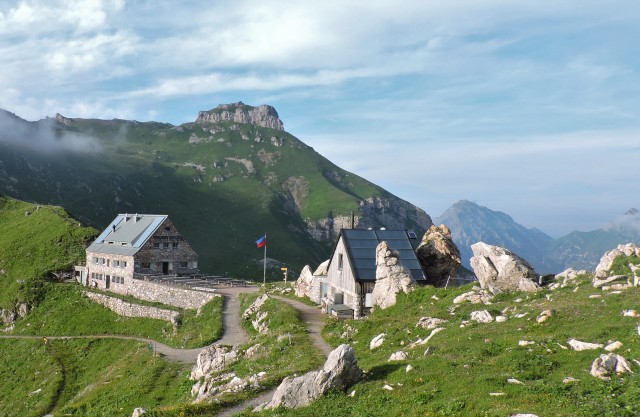
Pfälzerhütte, Liechtenstein
The three youngest members of the hut staff were extremely cordial and hospitable. However, the older woman who was the “hut warden” treated us rudely. [So…while in Liechtenstein, two older women in charge of lodgings seemed hostile toward us. Why? Our daughter speaks German very well, and even my wife and I speak a little German. Were these Liechtensteiner older women biased against Americans? Or against English-speakers in general?]
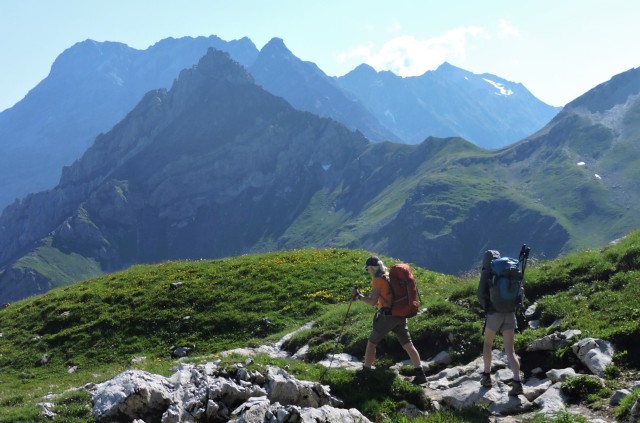
On the Via Alpina red trail in Austria, headed for Switzerland.
Proceeding with the next stage of the Via Alpina red trail, we passed through a small corner of Austria and then entered Switzerland. The views were absolutely spectacular, so much so that we stopped often just to take it all in. Once while doing so, we heard the sound of an alphorn from far off, playing a traditional tune. Only in the Alps….
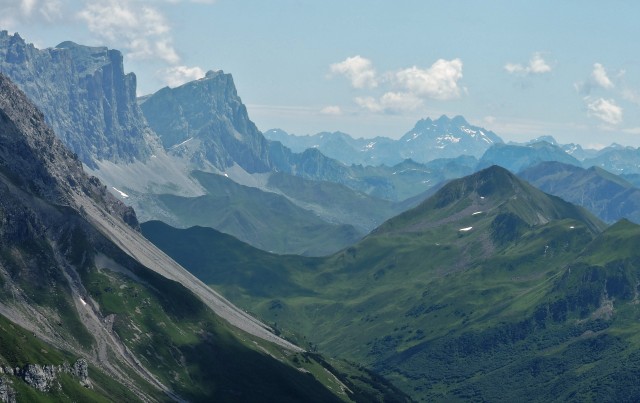
The route of the Via Alpina red trail follows the foot of the line of peaks on the left (known as the Alpstein) and crosses the many saddles visible in the middle of the photo.
This stage of the trail is totally above timberline, making for nonstop alpine views. The stage ends at Schesaplanahütte, owned by the Swiss Alpine Club. The hut is situated high on a ridge, allowing excellent views in various directions. Both simple bedrooms or massenlager are available. The entire hut staff was especially professional, welcoming and generous. The food was plentiful and of the highest quality. Schesaplanahütte offers rooms with beds or massenlager. We stayed three nights, making day trips in the area.
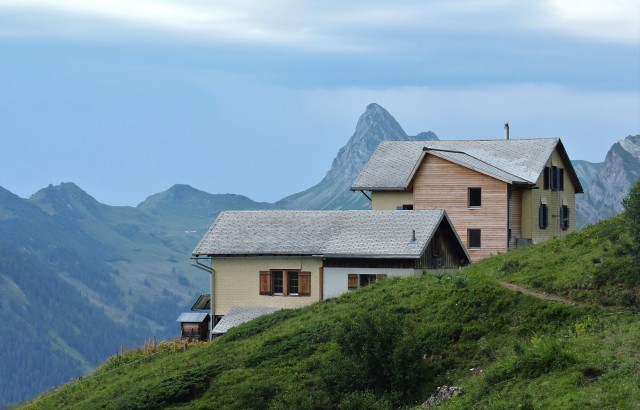
Schesaplanahütte
By the time we were ready to move on to the next stage of the Via Alpina, we were faced with a decision. We’d been dodging rain and lightning for several days, and this particular day’s forecast was sketchy. The route ahead was entirely above treeline, and we didn’t want to be caught out in the open during a thunderstorm. After consulting with the hut warden, we decided to go for it.
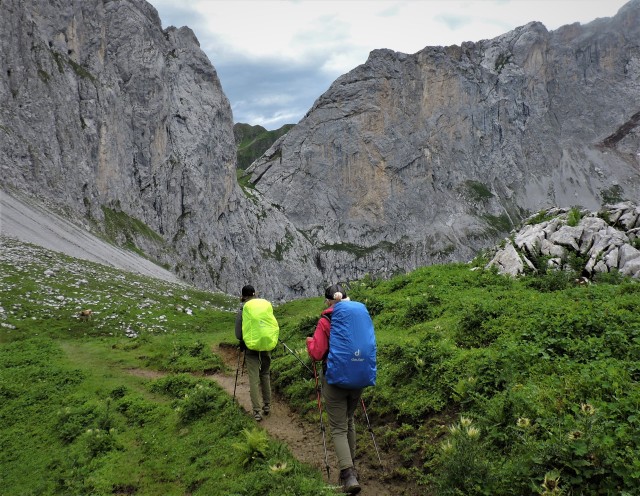
Approaching the Schweizer Tor (Swiss Gate) on our way along the Via Alpina red trail toward Berghaus Sulzfluh.
All morning as we hiked along, nasty storms approached from the west and then veered off and missed us. But at mid-day we passed the Schweizer Tor (the Swiss Gate that reminded us of something from the Lord of the Rings movies), and the wind began to howl; we realized then that we weren’t going to avoid the storms after all. The rain hit us soon thereafter, and continued full blast for the rest of the day. The trail was in poor condition to start with: the tread was a good 10 inches below the surface of the surrounding ground, and frequently braided. With rain pelting down, the trail flowed like a stream with water several inches deep. We passed Carschinahütte (which, although typically the end of this stage of the Via Alpina, was full-up), and arrived instead at Berghaus Sulzfluh, drenched to the skin. The young ladies in charge at Sulzfluh welcomed us very warmly, and we enjoyed an excellent dinner and then a comfortable sleep (in an historic room lit by candle). The next morning we made our way down the valley to St. Antonien, where our journey on part of the Via Alpina red trail came to an end.
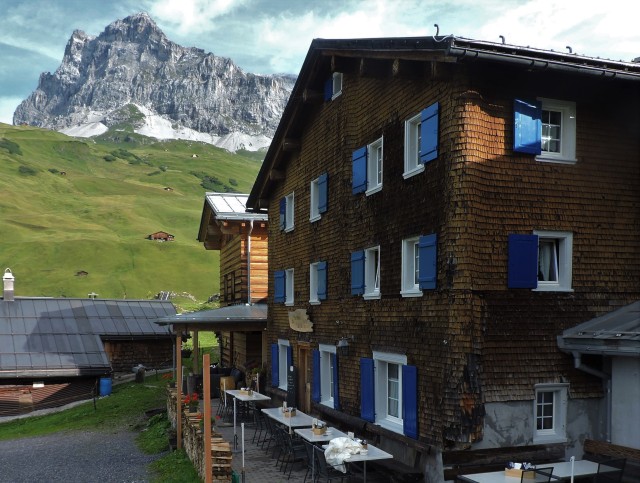
Berghaus Sulzfluh, on the morning after the storm.
If you plan to hike these stages of the Via Alpina red trail during the high season, reserve your hut accommodations well in advance (they were packed when we were there). Also be aware that neither Pfälzerhütte nor Schesaplanahütte accept credit cards (you must bring cash!). I know of no guidebook to the red trail in English. We used Swisstopo “wanderkarte” 1:50,000 maps for the Montafon (238T) and Prättigau (248T) regions. And pray for clement weather, especially when crossing the highest passes.
Interestingly, while on this trek we never saw any other native English-speakers: no other Americans, Brits, Canadians, Aussies or Kiwis.
A reminder about how to use this blog to learn about the other Via Alpina, the “green trail”: we hiked the green trail across Switzerland in two trips. In 2013, we hiked west to east, from Lenk to Engelberg. Then in 2016, we hiked the trail from east to west, from Mels to Engelberg. So to read about hiking the green trail, scroll down until you see my stage-by-stage “trail diary” posts from 2013 and 2016.
Happy trails!

